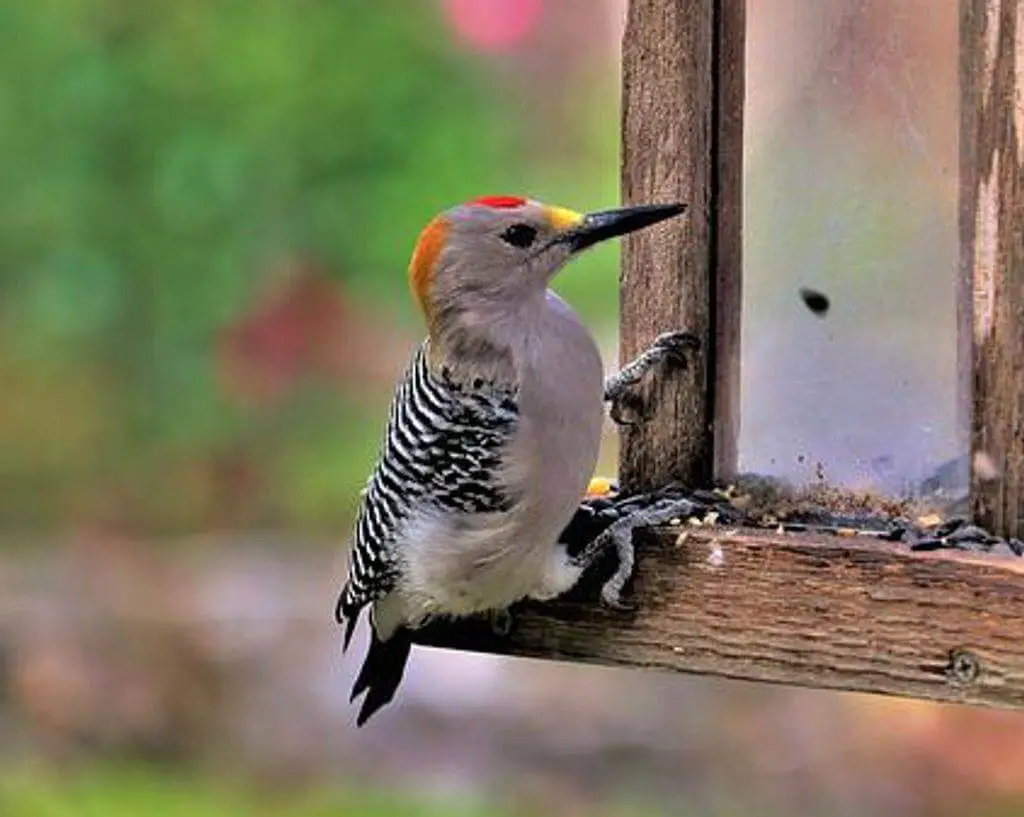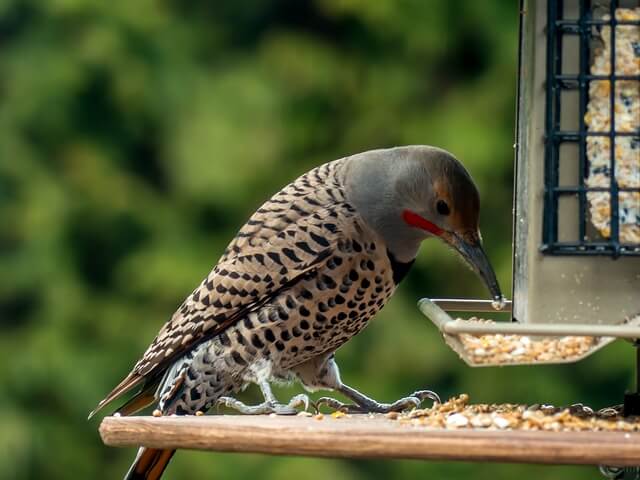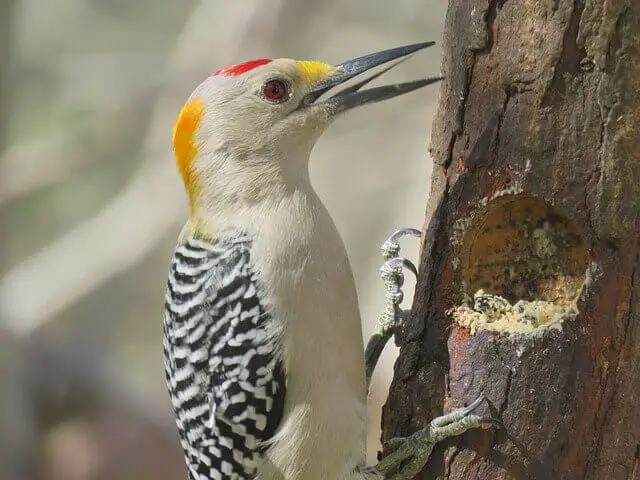Welcome to our expert guide on the woodpeckers of Florida! With its diverse ecosystems and abundant woodlands, Florida is home to a variety of woodpecker species, each with its own unique characteristics and behaviors. Join us as we embark on a journey to explore the nine types of woodpeckers found in Florida, from the iconic Pileated Woodpecker to the diminutive Downy Woodpecker.
Table of Contents
Types of Woodpeckers in Florida
Red-bellied Woodpecker
- Length: 9.5 in (24 cm)
- Weight: 2.0-3.2 oz (56-90 g)
- Wingspan: 13.0-16.5 in (33-42 cm)
- Frequency of Occurrence: 42.72% (Statistic by: eBird)
- Where To Find Them: They like to live in forests near bodies of water. Some of the best places to see them in the state are at Wakulla Springs State Park, Paynes Prairie Preserve State Park, and Big Cypress National Preserve.
- How to Attract:They are easily attracted to feeders with suet or peanut butter. If you want to attract these birds to your backyard, make sure you have a variety of food options available, including insects, nuts, and berries. You can also provide a bird bath and some shelter in the form of a tree or bush.
The Red-bellied Woodpecker is a common bird found in eastern North America. It ranges from south central Canada to Florida, and west to Texas and Oklahoma.
The Red-bellied Woodpecker prefers forested areas with large trees, but can also be found in parks, suburbs, and other open areas. This woodpecker feeds on insects, primarily ants and beetles, which it extracts from trees or the ground.
Related Post: How to Attract Red-bellied Woodpeckers to your Yard?
Downy Woodpecker
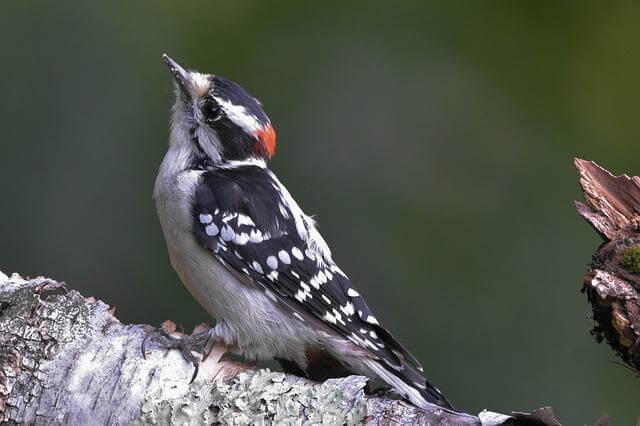
- Length: 5.5-6.7 in (14-17 cm)
- Weight: 0.7-1.0 oz (21-28 g)
- Wingspan: 9.8-11.8 in (25-30 cm)
- Frequency of Occurrence: 19.24%
- Where To Find Them: Downy Woodpeckers can be seen throughout Florida, but some of the best places to see them include the Ocala National Forest, Crystal River State Park, and the St. John’s River Water Management Area. They can also be seen at various birding hotspots such as DeLeon Springs State Park and Merritt Island National Wildlife Refuge.
- How to Attract: One thing you can do is provide them with a source of water. Downy Sapsuckers need a lot of water to drink, so placing a birdbath or other watering hole in your yard will give them what they need. You can also provide them with food by putting out some suet or other bird feed. The best way to attract Downy Sapsuckers, however, is by putting up some dead trees or logs.
Downy Woodpeckers are the smallest North American woodpeckers. The Downy Woodpecker ranges from southeastern Alaska to southern California, and east to the Great Plains.
It prefers habitats with mature trees, such as forests, parks, and suburban yards. Downy Woodpeckers eat insects, primarily beetles, caterpillars, and ants which it catches by pecking them from tree bark or branches. They also eat fruit and nuts.
Related Post:
- How to Attract Downy Woodpeckers to Your Yard? (Easy!)
- 7 Birds That Look Like Downy Woodpecker (Explained)
Pileated Woodpecker

- Length: 15.8-19.3 in (40-49 cm)
- Weight: 8.8-12.3 oz (250-350 g)
- Wingspan: 26.0-29.5 in (66-75 cm)
- Frequency of Occurrence: 15.11%
- Where To Find Them: One of the best places is in the Ocala National Forest, where they can often be seen in the hardwood hammocks and along the creeks. They can also be found in other parts of northern Florida, such as at Paynes Prairie Preserve State Park and Edward Ball Wakulla Springs State Park.
- How to Attract: These woodpeckers are attracted to large dead trees, where they excavate nesting cavities. If you want to attract pileated woodpeckers to your backyard, you will need to provide them with a dead tree or large section of a dead tree. You can also provide them with a platform feeder full of suet or peanuts.
The Pileated woodpecker is a large, black and white woodpecker that is found in eastern North America. It has a range that extends from southeastern Manitoba in Canada south to Florida, and west to Texas. The pileated woodpecker inhabits a variety of habitats, including deciduous forests, coniferous forests, and mixed woods.
It is also found in parks, orchards, and suburban areas. The diet of the pileated woodpecker consists mainly of insects, but it also eats fruit and tree sap.
Related Post: How to Attract Pileated Woodpeckers to your Yard (Fast)
Northern Flicker
- Length: 11.0-12.0 in (28-31 cm)
- Weight: 3.9-5.6 oz (110-160 g)
- Wingspan: 16.5-20.0 in (42-51 cm)
- Frequency of Occurrence: 3.92%
- Where To Find Them: Some of the best places to see them are in the Ocala National Forest, around Lake Kissimmee, and in the Everglades.
- How To Attract: A good way to attract them to your yard is to offer a variety of food options, including sunflower seeds, millet, cracked corn, and live or frozen insects. Be sure to place your bird feeder in an area where it will be visible from a window, so you can watch these beautiful birds up close. Trees and shrubs that provide good cover for Northern Flickers include dogwoods, hawthorns, pines, and spruces.
The Northern Flicker is a medium-sized woodpecker that can be found in open woodlands, forest edges, and yards across Canada and the United States. In terms of habitat, they are commonly found around deciduous forests, but they can also live in montane forests or urban settings.
Northern flickers eat a variety of things, including insects, nuts, seeds, fruits, and carrion. They can scavenge on the ground or climb trees to procure food. Northern flickers are year-round residents in most of their range, but some birds may migrate south in winter.
Related Post: How to Attract Northern Flickers to your Backyard (Easy)
Yellow-bellied Sapsucker
- Length: 7.1-8.7 in (18-22 cm)
- Weight: 1.5-1.9 oz (43-55 g)
- Wingspan: 13.4-15.8 in (34-40 cm)
- Frequency of Occurrence: 3.68%
- Where To Find Them: Some of the best places to see them in the state of Florida include around Tampa Bay, St. Augustine, and the Ocala National Forest.
- How to Attract: There are a few things you can do to attract these birds to your property, and it’s important to keep in mind that they will only visit if there is food available.
One way to attract yellow-bellied sapsuckers is to put up a birdfeeder that includes a suet block or some other type of bird food that these birds enjoy. You can also drill holes in a tree and hang a suet feeder from it, or place a large chunk of suet near the trunk of the tree.
The Yellow-bellied Sapsucker is a medium-sized woodpecker that can be found in various parts of North America. They typically reside in forests and wooded areas, but can also be seen in parks and residential areas.
These birds primarily feed on sap from trees, but also consume insects, fruits, and nuts. Yellow-bellied sapsuckers usually migrate during the winter months, but some may stay in milder climates throughout the year.
Related Post: 16 Interesting Sapsucker Facts Revealed!
Red-headed Woodpecker
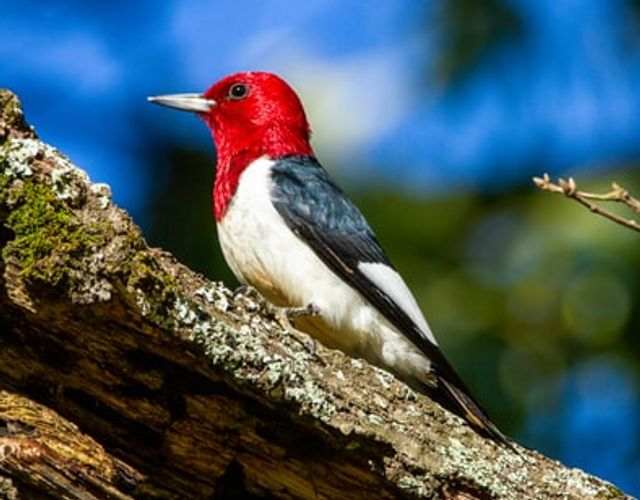
- Length: 7.5-9.2 in (19-23 cm)
- Weight: 2.0-3.2 oz (56-91 g)
- Wingspan: 16.5 in (42 cm)
- Frequency of Occurrence: 2.03%
- Where To Find Them: Some good areas to see them include Lake Wales Ridge State Forest, Paynes Prairie Preserve State Park, and Ocala National Forest.
- How to Attract: Woodpeckers need a large area with plenty of trees for nesting, roosting, and foraging. They also need a source of water. Suitable trees for nesting include oak, hickory, ash, and poplar. The bark of these trees is usually rougher than other trees, which is why woodpeckers prefer them. Woodpeckers also like to eat insects, so providing a suet feeder will help attract them to your yard.
The Red-headed woodpecker is a medium-sized woodpecker found in North America. It is the only woodpecker that is common in both the eastern and western parts of the continent.
The bird ranges from southern Canada to central Mexico, and can be found in a variety of habitats, including forests, prairies, and even urban areas. The diet of the red-headed woodpecker consists mostly of insects, but the bird will also eat fruit, nuts, and seeds.
Related Post:
- Interesting Red-Headed Woodpecker Facts (Explained)
- Birds That Look Like A Red-headed Woodpecker(Explained)
Red-cockaded Woodpecker
- Length: 7.9-9.1 in (20-23 cm)
- Weight: 1.5-1.8 oz (42-52 g)
- Wingspan: 14.2 in (36 cm)
- Frequency of Occurrence: 0.4254%
- Where To Find Them: Some of the best places to see them are in the Ocala National Forest and the Apalachicola National Forest. They can also be seen in other parts of Florida, including the Everglades National Park and Big Cypress National Preserve.
- How to Attract: To attract Red-cockaded Woodpeckers, you can provide them with suet, peanuts, or fruit. You can also make a wooden baffle to place around your birdfeeder to keep other birds from stealing the food.
The Red-cockaded woodpecker is a small bird that lives in the southeastern United States. It is the only woodpecker in the country that lives exclusively in pine forests. These birds can be found in South Carolina, North Carolina, Georgia, and Florida.
The red-cockaded woodpecker’s habitat is made up of longleaf and slash pine forests. These birds get most of their food from live pine trees, but they will also eat insects, spiders, and other small animals.
Hairy Woodpecker
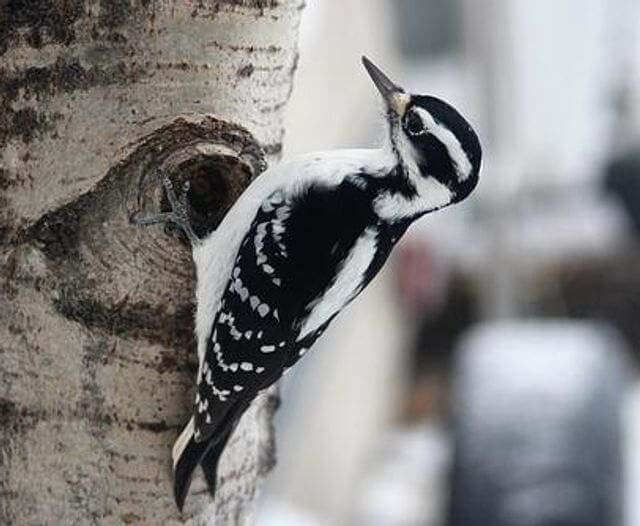
- Length: 7.1-10.2 in (18-26 cm)
- Weight: 1.4-3.4 oz (40-95 g)
- Wingspan: 13.0-16.1 in (33-41 cm)
- Frequency of Occurrence: 0.2337%
- Where To Find Them: Some of the best places to see them in Florida include the Ocala National Forest, the Everglades National Park, and the Osceola National Forest. They can also be seen in other parts of the state, including along the Gulf Coast and in the Panhandle.
- How to Attract: These birds are attracted to dead trees and other rotting wood, where they search for insects. You can attract these birds to your backyard by providing them with a dead tree or log, as well as a bird feeder filled with suet or insects.
The Hairy Woodpecker is a medium-sized woodpecker that can be found in North America and parts of Central America. They are usually black and white, with a red crest on their head.
They live in forests and other wooded areas, where they eat insects, spiders, and other small invertebrates. This woodpecker can be seen climbing up trees to look for food, or clinging to the bark while tapping it with their beak to find hidden insects.
Golden-fronted Woodpecker
- Length: 8.5-10.4 in (22-26 cm)
- Weight: 2.6-3.5 oz (73-99 g)
- Wingspan: 16.5-17.3 in (42-44 cm)
- Frequency of Occurrence: 0.0002%
- Where To Find Them: The best areas to see them in Florida are around Lake Okeechobee and in the Big Cypress National Preserve.
- How to Attract: They can be attracted to backyard feeders by providing a variety of foods, such as suet, sunflower seeds, and cracked corn. Golden-fronted Woodpeckers also like to bathe in shallow water, so providing a birdbath or pool will also attract them.
The Golden-fronted woodpecker is a medium-sized woodpecker that is found in the southwestern United States and Mexico. They are typically found in open woodlands and riparian areas.
These birds feed on a variety of insects, including ants, beetles, and caterpillars. They also eat fruit and seeds. Golden-fronted woodpeckers can be seen hammering away on trees to find food or excavating nesting cavities.
Ivory-billed Woodpecker (Declared Extinct 2021)
- Length: 18.1-20.1 in (46-51 cm)
- Weight: 15.9-20.1 oz (450-570 g)
- Wingspan: 29.9-31.5 in (76-80 cm)
- Frequency of Occurrence: 0.0001% (Declared Extinct)
The Ivory-billed Woodpecker was a large woodpecker that was found in the eastern and central United States. The bird’s habitat was mainly in forests, and it fed on insects, nuts, and fruit.
The Ivory-billed Woodpecker was considered extinct as of September 29, 2021, after no sightings of the bird had been reported since 1944. The deforestation of the Ivory-billed Woodpecker’s habitat resulted in significant decreases in populations.
Related Post:

